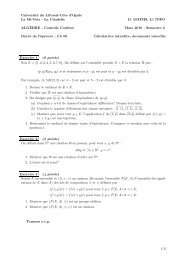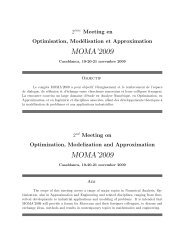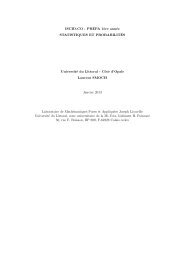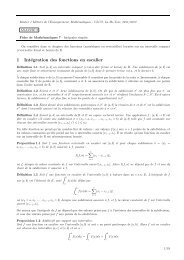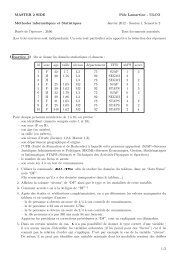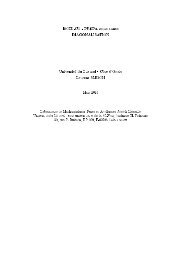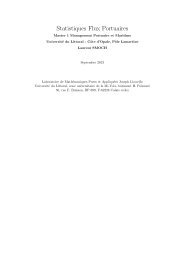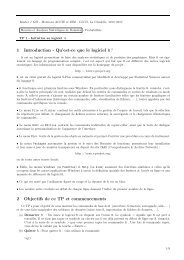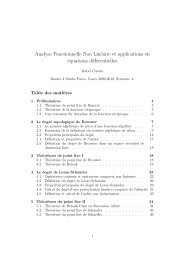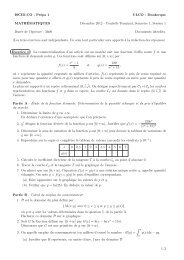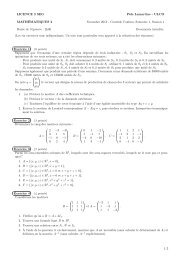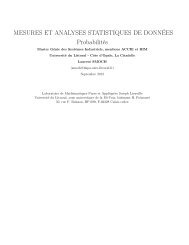download pdf - LMPA - Université du Littoral Côte d'Opale
download pdf - LMPA - Université du Littoral Côte d'Opale
download pdf - LMPA - Université du Littoral Côte d'Opale
You also want an ePaper? Increase the reach of your titles
YUMPU automatically turns print PDFs into web optimized ePapers that Google loves.
Elementary characterisation of small quantaloids of closed criblesHans Heymans ∗ and Isar Stubbe †March 17, 2011AbstractEach small site (C, J) determines a small quantaloid of closed cribles R(C, J). We provethat a small quantaloid Q is equivalent to R(C, J) for some small site (C, J) if and only ifthere exists a (necessarily subcanonical) Grothendieck topology J on the category Map(Q)of left adjoints in Q such that Q ∼ = R(Map(Q), J), if and only if Q is locally localic, mapdiscrete,weakly tabular and weakly mo<strong>du</strong>lar. If moreover coreflexives split in Q, then thetopology J on Map(Q) is the canonical topology.1. Intro<strong>du</strong>ctionA quantaloid Q is, by definition, a category enriched in the symmetric monoidal closed categorySup of complete lattices and supremum-preserving functions [Rosenthal, 1996]. Viewing Q as abicategory, it is natural to study categories, functors and distributors enriched in Q [Bénabou,1967; Street, 1983; Stubbe, 2005a]. A major application of quantaloid-enriched category theorywas discovered by B. Walters, and published in this journal: in [1982], he proved that the toposof sheaves on a site (C, J) is equivalent to the category of symmetric and Cauchy completecategories enriched in the small quantaloid of closed cribles R(C, J) constructed from the givensite.Given the importance of the construction of the quantaloid of closed cribles R(C, J) from asmall site (C, J), we provide in this paper an elementary axiomatisation of this notion. Precisely,we prove that a small quantaloid Q is equivalent to R(C, J) for some small site (C, J) if andonly if there exists a Grothendieck topology J on the category Map(Q) of left adjoints in Q suchthat Q ∼ = R(Map(Q), J), if and only if Q is locally localic, map-discrete, weakly tabular andweakly mo<strong>du</strong>lar. (The latter two notions seem to be new, and inherited their name from thestronger notions of tabularity and mo<strong>du</strong>larity intro<strong>du</strong>ced in [Freyd and Scedrov, 1990].) TheGrothendieck topology J on Map(Q) is always subcanonical, and if coreflexives split in Q, thenJ is the canonical topology.This result thus spells out how two, at first sight quite different, generalisations of locales,namely Grothendieck topologies on the one hand, and quantaloids on the other, relate: theformer can be understood to form an axiomatically described subclass of the latter. It is hoped∗ Department of Mathematics and Computer Science, University of Antwerp, Middelheimlaan 1, 2020 Antwerpen,Belgium, hans.heymans@ua.ac.be† Laboratoire de Mathématiques Pures et Appliquées, Université <strong>du</strong> <strong>Littoral</strong>-Côte d’Opale, 50 rue F. Buisson,62228 Calais, France, isar.stubbe@lmpa.univ-littoral.fr1
that this axiomatisation helps to clarify the role that quantaloids may play in the search for agood notion of “non-commutative topology”, to be used ultimately in suitable generalisations ofsheaf theory (see e.g. [Borceux and Van den Bossche, 1986; Mulvey and Nawaz, 1995; Amblerand Verity, 1996; Höhle, 1998; Gylys, 2001; Garraway, 2005; Stubbe, 2005b]).2. Small quantaloids of closed criblesTo begin, we recall a construction <strong>du</strong>e to [Walters, 1982]. If C is a small category, then thequantaloid R(C) of cribles in C is the full sub-quantaloid of Rel(Set Cop ) whose objects are therepresentable presheaves. It is useful to have an explicit description. We write a span in C as(f, g): X Y , and intend it to be a pair of arrows with dom(f) = dom(g), cod(f) = Y andcod(g) = X:· g f X Y (f, g)(Many would consider such a pair to be a span in the opposite direction, but the reason for ournotational convention for domain and codomain will become clear when we compose cribles.)A crible R: X Y is then a set of spans X Y such that for any (f, g) ∈ R and any h ∈ Cwith cod(h) = dom(f), also (f ◦ h, g ◦ h) ∈ R. Composition in R(C) goes as follows: forR: X Y and S: Y Z the elements of S ◦ R: X Z are those (f, g) for which there existsa morphism t ∈ C such that (f, t) ∈ S and (t, g) ∈ R. The identity crible id X : X X is the set{(f, f) | cod(f) = X}. (Here we need C to be small: otherwise id X isn’t necessarily a set.) Thesupremum of a set of cribles from X to Y is simply their set-theoretic union.Next recall from [Mac Lane and Moerdijk, 1992] that a Grothendieck topology J on a smallcategory C is a function, assigning to every object C a set J(C) of sieves on C, that satisfiesthree conditions:- ⊤ C := {f ∈ C | cod(f) = C} ∈ J(C),- if S ∈ J(C) then f ∗ (S) := {g ∈ C | f ◦ g ∈ S} ∈ J(D) for any f: D C in C,- if S ∈ J(C) and T is a sieve on C such that s ∗ (T ) ∈ J(dom(s)) for all s ∈ S, then T ∈ J(C)too.An element of J(C) is a covering sieve on C; the couple (C, J) is a small site.A nucleus j on a quantaloid Q is a lax functor j: Q Q which is the identity on objects andsuch that each j: Q(X, Y ) Q(X, Y ) is a closure operator; it is locally left exact if it preservesfinite infima of arrows. Grothendieck topologies J on C are in bijective correspondence withlocally left exact nuclei j on R(C) [Betti and Carboni, 1983; Rosenthal, 1996], as follows: For aGrothendieck topology J on C, let j: R(C) R(C) send a crible R: C D to{}j(R) := (f, g): C D ∣ ∃S ∈ J(dom(f)) : ∀s ∈ S, (g ◦ s, f ◦ s) ∈ R .Conversely, if j: R(C) R(C) is a locally left exact nucleus, then put{}J(C) := S is a sieve on C ∣ id C ≤ j({(s, s) | s ∈ S}) .2
If j: Q Q is a nucleus on a quantaloid, then there is a (“quotient”) quantaloid Q j of j-closedmorphisms, i.e. those f ∈ Q for which j(f) = f: the composition is j(g ◦ f), the identity on anobject X is j(1 X ), and the supremum of a family (f i ) i∈I is j( ∨ i f i). For a small site (C, J) wewrite R(C, J) for the quantaloid R(C) j with j the nucleus determined by the topology J.Definition 2.1 (Walters, 1982) A small quantaloid of closed cribles is a small quantaloidwhich is equivalent to R(C, J) for some small site (C, J).To be precise, Walters [1982] called this a ‘bicategory of relations’, wrote it as Rel(C, J), andcalled its arrows ‘relations’. However, to avoid confusion with the ‘bicategories of relations’ that[Carboni and Walters, 1987] and others have since then worked on, we prefer to stick closer tothe actual construction and speak of a ‘quantaloid of closed cribles’.In the remainder of this paper we develop an axiomatic description of the class of smallquantaloids of closed cribles, purely in terms of composition and local suprema/infima. We startby preparing the ground in the next section, in which we indicate several key properties of suchquantaloids.3. Weak tabularity, weak mo<strong>du</strong>larityRecall that an involution on a quantaloid Q is a Sup-functor (−) o : Q op Q which is the identityon objects and satisfies f oo = f for any morphism f in Q; the pair (Q, (−) o ) is then said toform an involutive quantaloid, but most of the time we do not explicitly mention the functor(−) o and simply speak of ‘an involutive quantaloid Q’. If a morphism f: X Y in a quantaloidQ is a left adjoint, then we write its right adjoint as f ∗ : Y X. To avoid overly bracketedexpressions we often write gf instead of g ◦ f for the composition of two morphisms f: X Yand g: Y Z in Q. The next definition gathers some technical conditions which will show upin the main theorem in the next section.Definition 3.1 A quantaloid Q is:1. locally localic if, for all objects X and Y , Q(X, Y ) is a locale,2. map-discrete if, for any left adjoints f: X Y and g: X Y in Q, f ≤ g implies f = g,3. weakly tabular if, for every q: X Y in Q,q = ∨ ∣ }{fg ∗ ∣∣ (f, g): X Y is a span of left adjoints such that fg ∗ ≤ q ,4. map-tabular if for every q: X Y in Q there is a span (f, g): X Y of left adjoints inQ such that fg ∗ = q and f ∗ f ∧ g ∗ g = 1 dom(f) ,5. weakly mo<strong>du</strong>lar if, for every pair of spans of left adjoints in Q, say (f, g): X Y and(m, n): X Y , we have fg ∗ ∧ mn ∗ ≤ f(g ∗ n ∧ f ∗ m)n ∗ ,6. tabular if it is involutive and if for every q: X Y in Q there exists a span (f, g): X Yof left adjoints in Q such that fg o = q and f o f ∧ g o g = 1 dom(f) ,3
7. mo<strong>du</strong>lar if it is involutive and if for any f: X Y , g: Y Z and h: X Z in Q wehave gf ∧ h ≤ g(f ∧ g o h) (or equivalently, gf ∧ h ≤ (g ∧ hf o )f).The notions of mo<strong>du</strong>larity and tabularity are <strong>du</strong>e to [Freyd and Scedrov, 1990]; we believe thatweak mo<strong>du</strong>larity, weak tabularity and map-tabularity are new notions. Note that conditions 1–5in the definition above make sense in any quantaloid, whereas conditions 6–7 are only defined foran involutive quantaloid. In the next two lemmas we record some straightforward implications.Lemma 3.2 If a quantaloid Q is map-tabular then it is also weakly tabular.Lemma 3.3 If Q is a mo<strong>du</strong>lar quantaloid then:1. if f: A B is a left adjoint morphism in Q then f ∗ = f o ,2. Q is map-discrete,3. Q is weakly mo<strong>du</strong>lar,4. Q is tabular if and only if it is map-tabular.Now we can easily point out our main example:Example 3.4 For any small category C, the quantaloid R(C) of cribles in C is an involutivequantaloid: the involute R o : D C of a crible R: C D is obtained by reversing the spans inR. It is easy to see that R(C) is locally localic and mo<strong>du</strong>lar, and by Lemma 3.3 it is thus alsomap-discrete and weakly mo<strong>du</strong>lar. Furthermore, it is weakly tabular: if we write 〈f, g〉: C Dfor the crible generated by a span (f, g): C D (in the obvious way), then it is straightfowardto check that, given a crible R: C D, we may writeR = ⋃ }{〈f, 1〉 ◦ 〈1, g〉 ∣ (f, g) ∈ R ,where 〈f, 1〉 is a left adjoint, and 〈1, g〉 a right adjoint, in R(C).If J is a Grothendieck topology on C, then R(C, J) too is involutive, because the correspondinglocally left exact nucleus j: R(C) R(C) preserves the involution. Moreover, the involutivequantaloid R(C, J) is locally localic and mo<strong>du</strong>lar, because R(C) is so and j preserves theseproperties; thus, R(C, J) is also map-discrete and weakly mo<strong>du</strong>lar. Moreover, R(C, J) is weaklytabular, again because R(C) is so and j preserves this property.In the rest of this section, we relate the notions summed up in Definition 3.1; strictly speaking,none of these results are needed for the proof of our main theorem in the next section, but theyare interesting in their own right. We start with a less straightforward relation between maptabularityand weak tabularity in the next proposition, making use of the quantaloid Dist(Q) ofQ-enriched categories and distributors (= mo<strong>du</strong>les = profunctors) between them. We typicallywrite Φ: A ❝ B for an arrow in Dist(Q) (whose elements are Q-arrows Φ(b, a): ta tb), whereasthe composition with another Ψ: B ❝ C is written as Ψ ⊗ Φ: A ❝ C (and has elements (Ψ ⊗Φ)(c, b) = ∨ b∈BΨ(c, b)◦Φ(b, a)). We refer to [Stubbe, 2005a] for more details and for historicallyrelevant references.4
Proposition 3.5 A small quantaloid Q is weakly tabular if and only if Dist(Q) is map-tabular. Proof : Fist suppose that Dist(Q) is map-tabular. A Q-arrow q: X Y may be viewed asa distributor between one-object Q-categories with identity homs: (q): ∗ X❝ ∗ Y . Thus, thereexist left adjoint distributors α: A ❝ ∗ Y and β: A ❝ ∗ X satisfying in particular α ⊗ β ∗ = (q).Spelled out, this means thatq = ∨ {α(x) ◦ β ∗ (x) ∣ x ∈ A 0}.But it is easily seen that α(x) ⊣ α ∗ (x) and β(x) ⊣ β ∗ (x) for all x ∈ A 0 . Thus each pair(α(x), β(x)) is a span of left adjoints in Q, satisfying α(x) ◦ β ∗ (x) ≤ q, and the above equationimplies that Q is weakly tabular.Conversely, supposing that Q is weakly tabular, we seek, for any given distributor Φ: B ❝ Abetween Q-categories, left adjoint distributors Σ: R ❝ A and Θ: R ❝ B such that Σ ⊗ Θ ∗ = Φand Σ ∗ ⊗ Σ ∧ Θ ∗ ⊗ Θ = R. We may suppose for convenience that A and B are Cauchycomplete (because in Dist(Q) every Q-category is isomorphic to its Cauchy completion), sothat any left adjoint distributor into A or B is necessarily representable. Thus our problembecomes: to find functors S: R B and T : R A such that B(−, S−) ⊗ A(T −, −) = Φ andB(S−, S−) ∧ A(T −, T −) = R. Thereto, we define the Q-category R to be the full subcategoryof A × B whose objects are those (a, b) ∈ A × B for which 1 ta ≤ Φ(a, b). Explicitly, R is givenby:- objects: R 0 = {(a, b) ∈ A 0 × B 0 | ta = tb and 1 ta ≤ Φ(a, b)} with types t(a, b) = ta = tb,- hom-arrows: R((a ′ , b ′ ), (a, b)) = A(a ′ , a) ∧ B(b ′ , b).Naturally, we let T (resp. S) be the composition of the inclusion R ↩→ A × B with the projectionof A × B onto A (resp. onto B). By construction we then have B(S−, S−) ∧ A(T −, T −) = R;and a computation shows furthermore that, for any a ∈ A 0 and b ∈ B 0 ,∨A(a, T −) ◦ B(S−, b) = A(a, T (x, y)) ◦ B(S(x, y), b)(x,y)∈R 0∨= A(a, x) ◦ B(y, b)(x,y)∈R 0∨≤ A(a, x) ◦ Φ(x, y) ◦ B(y, b)(x,y)∈R 0∨≤ A(a, x) ◦ Φ(x, y) ◦ B(y, b)∨x∈A y∈B≤ Φ(a, b)(using that Φ(x, y) ≥ 1 tx to pass from the second line to the third). It remains to prove thatΦ(a, b) ≤ A(a, T −) ⊗ B(S−, b) holds too. By weak tabularity of Q, it suffices to show that, forany span (f, g): tb ta of left adjoints in Q,f ◦ g ∗ ≤ Φ(a, b) =⇒ f ◦ g ∗ ≤ A(a, T −) ◦ B(S−, b).5
Because we assumed that A is Cauchy complete, we can consider the tensor 1 a ⊗ f ∈ A of theobject a ∈ A 0 with the left adjoint morphism f in Q; reckoning that f ⊣ f ∗ in Q we havemoreover that the tensor a ⊗ f equals the cotensor 〈f ∗ , a〉 of a with f ∗ . A straightforwardcomputation with the universal property of (co)tensors shows thatA(x, 〈f ∗ , a〉) = A(x, a) ◦ f and A(a ⊗ f, y) = f ∗ ◦ A(a, y)for all x, y ∈ A. Similar calculations can be made for the (co)tensor b ⊗ g = 〈g ∗ , b〉 in B. Fromthis it follows easily thatΦ(a ⊗ f, b ⊗ g) = A(a ⊗ f, −) ⊗ Φ ⊗ B(−, 〈g ∗ , b〉) = f ∗ ◦ Φ(a, b) ◦ gfrom which we can de<strong>du</strong>ce thatf ◦ g ∗ ≤ Φ(a, b) ⇐⇒ 1 X ≤ Φ(a ⊗ f, b ⊗ g) ⇐⇒ (a ⊗ f, b ⊗ g) ∈ R.But this in turn implies thatas wanted.A(a, T −) ⊗ B(S−, b) =∨(x,y)∈RA(a, T (x, y)) ◦ B(S(x, y), b)≥ A(a, a ⊗ f) ◦ B(b ⊗ g, b)= A(a, a) ◦ f ◦ g ∗ ◦ B(b, b)≥f ◦ g ∗In the next proposition, Matr(Q) denotes the quantaloid of Q-typed sets and matrices withelements in Q between them. We write a matrix typically as M: X Y (and its elementsare Q-arrows M(y, x): tx ty), and its composition with another matrix N: Y Z as N ◦N: X Z (with elements (N ◦M)(z, x) = ∨ y∈YN(z, y)◦M(y, x)). (Thus, Matr(Q) is preciselythe quantaloid of discrete Q-enriched categories and distributors between them.)Proposition 3.6 A small involutive quantaloid Q is locally localic and mo<strong>du</strong>lar if and only ifMatr(Q) is mo<strong>du</strong>lar.Proof : First suppose that Q is locally localic and mo<strong>du</strong>lar, and let M: X Y , N: Y Z andP : X Z be arrows in Matr(Q): we must prove that, for any x ∈ X and z ∈ Z,( ∨y∈Y)N(z, y) ◦ M(y, x) ∧ P (z, x) ≤ ∨y ′ ∈Y[N(z, y ′ ) ◦(M(y ′ , x) ∧ ∨z ′ ∈Z)]N o (y ′ , z ′ ) ◦ P (z ′ , x) .1 By definition, the tensor a ⊗ f of an object a ∈ A and a morphism f: X ta in Q, is the colimit of thefunctor ∗ ta A: ∗ ↦→ a weighted by the distributor (f): ∗ X❝ ∗ ta. The <strong>du</strong>al notion is cotensor; we write 〈g, a〉for the cotensor of an object a ∈ A with a morphism g: ta Y in Q. If f ⊣ f ∗ in Q, then (f) is then a left adjointin Dist(Q), so a Cauchy complete Q-category A necessarily has all tensors a ⊗ f with left adjoint f. Moreover, inthis case, a ⊗ f = 〈f ∗ , a〉.✷6
By distributivity of ∧ over ∨ in Q, and mo<strong>du</strong>larity of Q, this can straightforwardly be verified:LHS = ∨ ()N(z, y) ◦ M(y, x) ∧ P (z, x)≤y∈Y∨y∈Y= ∨≤y∈Y∨y∈Y= RHS.[ ()]N(z, y) ◦ M(y, x) ∧ N(z, y) o ◦ P (z, x)[ ()]N(z, y) ◦ M(y, x) ∧ N o (y, z) ◦ P (z, x)[ ( ( ∨N(z, y) ◦ M(y, x) ∧z ′ ∈Z))]N o (y, z ′ ) ◦ P (z ′ , x)Secondly, suppose that Matr(Q) is mo<strong>du</strong>lar. Certainly Q is mo<strong>du</strong>lar too, for it is a fullsubcategory. To see that Q is locally localic, let f, (g i ) i∈I ∈ Q(X, Y ); we need to show thatf ∧ ( ∨ i g i) ≤ ∨ i (f ∧ g i) (the reverse inequality is trivial). To see this, we consider the followingsets and matrices:- {X}, the singleton whose single element is of type X,- {Y }, the singleton whose single element is of type Y ,- I, the index-set for which we set the type of each i ∈ I to Y ,- F : {X} {Y }, the matrix whose single entry is F (Y, X) = f,- G: {X} I, the matrix whose ith entry is G(i, X) = g i ,- 1: I {Y }, the matrix whose ith entry is 1(Y, i) = 1 Y .By these definitions, the morphism f ∧( ∨ i g i): X Y in Q is the single element of the Q-matrixF ∧ 1 ◦ G: {X} {Y }. By the hypothetical mo<strong>du</strong>larity of Matr(Q), the latter is less than orequal to 1 ◦ (1 o ◦ F ∧ G), whose single element in turn is ∨ i (f ∧ g i).✷Finally, we state a proposition concerning mo<strong>du</strong>larity and tabularity, which is proved withcalculations in the style of [Freyd and Scedrov, 1990, pages 223–224]; this will be useful inExample 4.6.Proposition 3.7 If an involutive quantaloid Q is mo<strong>du</strong>lar and tabular then it is locally localic.Proof : First remark that, for any morphism q: X Y in Q, the mo<strong>du</strong>lar law impliesq = q ∧ q ≤ q(1 X ∧ q o q) ≤ qq o q.(The condition that q ≤ qq o q for any morphism q in Q, is sufficient for many applicationsof mo<strong>du</strong>lar quantaloids; such a quantaloid Q is sometimes said to be “weakly Gelfand”.) Inparticular is any endomorphism m: X X such that m ≤ 1 X , necessarily an idempotent:mm ≤ m holds in general, and m ≤ mm o m ≤ mm follows from the argument above. It isthen straightforward that the sublattice ↓ 1 X ⊆ Q(X, X) of endomorphisms on X below 1 X , isa locale: because mn = m ∧ n for any m, n below 1 X .7
Now, for two objects X, Y ∈ Q, taking advantage of Lemma 3.3 we can choose f: U Xand g: U Y such that f o f ∧ g o g = 1 U , fg o = ⊤ Y,X , f ⊣ f o and g ⊣ g o . Thus there are adjointorder-preserving functions↓1 Um ↦→ m⊥ Q(U, U)1 U ∧ e↦→ee ↦→ feg o ⊥ Q(Y, X)f o qgso if we prove that the unit and counit inequalities of the composed adjunction↦→q↓1 Um ↦→ fmg o ⊥ Q(Y, X)1 U ∧ f o qgare in fact equalities, then Q(Y, X) is isomorphic (qua ordered set, thus also qua lattice) to thelocale ↓1 U , and hence itself a locale. The inverse of the counit is easy to check: using mo<strong>du</strong>laritytwice, we haveq = T Y,X ∧ q = fg o ∧ q ≤ f(g o ∧ f o q) ≤ f(1 U ∧ f o qg)g o .For the inverse of the unit, first observe that1 U ∧ f o fmg o g ≤ 1 U ∧ f o fmm o g o g = 1 U ∧ (f o fm)(g o gm) obecause m o ≤ (1 U ) o = 1 U . But for any morphisms a, b ∈ Q(V, U) we can compute with themo<strong>du</strong>lar law that 1 U ∧ab o = 1 U ∧(1 U ∧ab o )) ≤ 1 U ∧a(a o ∧b o )) ≤ (a∧b)(a∧b) o . In our situationthis implies that1 U ∧ (f o fm)(g o gm) o ≤ (f o fm ∧ g o gm)(f o fm ∧ g o gm) o .But because (f o fm ∧ g o gm) ≤ (f o f ∧ g o gmm o )m ≤ (f o f ∧ g o g)m = 1 U m = m ≤ 1 U (using themo<strong>du</strong>lar law, the fact that mm o ≤ 1 U , and the hypotheses on f and g) we find↦→(f o fm ∧ g o gm)(f o fm ∧ g o gm) o ≤ mm o ≤ mqas needed to conclude.✷4. Elementary characterisation of R(C, J)If Q is small then we can regard Map(Q) as a category and construct the quantaloid R(Map(Q))of cribles of left adjoints in Q. To compare R(Map(Q)) with the given Q, there is always thenormal colax functor F : R(Map(Q)) Q defined to send a crible of left adjoints in Q, sayR: D C, to the Q-morphismF (R) := ∨ { ∣ }fg ∗ ∣∣ (f, g) ∈ R ∈ Q(D, C).For any objects X and Y ,R(Map(Q))(Y, X) Q(Y, X): R ↦→ F (R)8
preserves arbitrary suprema, hence admits a right adjoint qua order-preserving function:Q(Y, X) R(Map(Q))(Y, X): q ↦→ F ∗ (q).Explicitly,F ∗ (q) ={}(f, g) ∈ R(Map(Q))(Y, X) ∣ fg ∗ ≤ qand it follows easily that this defines a lax functor F ∗ : Q R(Map(Q)). In the next two lemmas(the first of which is a mere triviality) we establish a link with the conditions in Definition 3.1.Lemma 4.1 For a small quantaloid Q, the following are equivalent:1. Q is weakly tabular,2. for all objects X, Y in Q, the adjunctionR(Map(Q))(Y, X)is split (ie. F (F ∗ (q)) = q for all q: Y3. F : R(Map(Q)) Q is full.F ⊥ Q(Y, X)F ∗ X in Q),Lemma 4.2 For a small weakly tabular and map-discrete quantaloid Q, F : R(Map(Q))a Sup-functor and( ) ()j: R(Map(Q) R(Map(Q)): R: Y X ↦→ F ∗ (F (R)): Y X Q isis a nucleus such that Q ∼ = R(Map(Q)) j .Proof : To prove that F is functorial we must show that F is lax on composites (for it is alwaysnormal colax): F (R) ◦ F (S) ≤ F (R ◦ S) for any R: Y X and S: Z Y in R(Map(Q)).Equivalently: if (f, g) ∈ R and (m, n) ∈ S then fg ∗ mn ∗ ≤ F (R ◦ S). Now, by weak tabularityof Q we know that g ∗ m = ∨ F ∗ (g ∗ m), sofg ∗ mn ∗ = ∨ ∣ }{fab ∗ n ∗ ∣∣ (a, b) ∈ F ∗ (g ∗ m) .But, for any (a, b) ∈ F ∗ (g ∗ m),ab ∗ ≤ g ∗ m ⇒ ga ≤ mb ⇒ ga = mbsince Q is map-discrete. From (fa, ga) ∈ R, (mb, nb) ∈ S and ga = mb, it further follows that(fa, nb) ∈ R ◦ S, whence fab ∗ n ∗ ≤ F (R ◦ S). Thus we obtain fg ∗ mn ∗ ≤ F (R ◦ S) as wanted.Secondly, j = F ∗ ◦F is a nucleus on R(Map(Q)) because it is a lax functor (it is the compositeof two lax functors) and because locally, for any objects X and Y ,R(Map(Q))(Y, X) R(Map(Q))(Y, X): R ↦→ j(R)is a closure operator (it is the composite of the left and right adjoint in Lemma 4.1). By Lemma4.1 it is furthermore clear that the quotient quantaloid R j (Map(Q)) is isomorphic to Q: therestriction of F : R(Map(Q)) Q to the j-closed cribles is the identity on the objects, and fullyfaithful on the morphisms.✷We can now prove our main result:9
Theorem 4.3 For a small quantaloid Q, the following conditions are equivalent:1. Q is locally localic, map-discrete, weakly tabular and weakly mo<strong>du</strong>lar,2. F : R(Map(Q)) Q is a full and locally left exact Sup-functor,3. putting, for X ∈ Map(Q),J(X) :={S is a sieve on X∣ 1 X = ∨ ss ∗}s∈Sdefines a Grothendieck topology J on Map(Q) for which Q ∼ = R(Map(Q), J),4. Q is a small quantaloid of closed cribles.In this case, Q carries an involution, sending q: Y X toq o := ∨ ∣ }{gf ∗ ∣∣ (f, g): Y X is a span of left adjoints such that fg ∗ ≤ q ,which makes Q a mo<strong>du</strong>lar quantaloid.Proof : (1 ⇒ 2) Lemma 4.2 provides everything except for the local left exactness of F . Thus itremains to prove that F (R) ∧ F (S) = F (R ∩ S) holds for morphisms R, S ∈ R(Map(Q))(Y, X).But F (R) ∧ F (S) ≥ F (R ∩ S) is trivial (because F is a Sup-functor), and to check the otherinequality it suffices – because Q is locally localic – to prove that fg ∗ ∧ mn ∗ ≤ F (R ∩ S) forany (f, g) ∈ R and (m, n) ∈ S. By weak mo<strong>du</strong>larity we have fg ∗ ∧ mn ∗ ≤ f(g ∗ n ∧ f ∗ m)n ∗ ,and by weak tabularity we further know that g ∗ n ∧ f ∗ m = ∨ F ∗ (g ∗ n ∧ f ∗ m), so it reallysuffices to prove that fab ∗ n ∗ ≤ F (R ∩ S) for any (a, b) ∈ F ∗ (g ∗ n ∧ f ∗ m). With an argumentsimilar to that in the proof of Lemma 4.2, using in particular map-discretess, it is easily seenthat (a, b) ∈ F ∗ (g ∗ n ∧ f ∗ m) implies fa = mb and ga = nb. Hence, from (fa, ga) ∈ R and(mb, nb) ∈ S it follows that (fa, nb) ∈ R ∩ S, which implies fab ∗ n ∗ ≤ F (R ∩ S) as wanted.(2 ⇒ 3) The nucleus j: R(Map(Q)) R(Map(Q)) of Lemma 4.2 is locally left exact becauseit is the composite of locally left exact lax functors (F ∗ even preserves all local infima). ButQ ∼ = R j (Map(Q)), as Lemma 4.2 attests, and R j (Map(Q)) is necessarily the small quantaloidof closed cribles R(Map(Q), J) for the unique Grothendieck topology on Map(Q) correspondingwith the locally left exact nucleus j: thusJ(X) ={S is a sieve on X}∣ id X ≤ j({(s, s) | s ∈ S})which is precisely the same thing as in the statement of the theorem.(3 ⇒ 4) Holds by Definition 2.1.(4 ⇒ 1) Was explained in Example 3.4.Finally, the involution q ↦→ q o results from the isomorphism in the third statement.We can say a bit more about the topology constructed in the previous theorem.✷Proposition 4.4 If Q is a small quantaloid of closed cribles, then the Grothendieck topology Jon Map(Q) as in Theorem 4.3 is subcanonical (i.e. each representable is a sheaf).10
Proof : Suppose that S ∈ J(C) is a covering sieve, thus ∨ s∈S ss∗ = 1 C . With the usualabuse of notation we shall write σ: S Map(Q)(−, C) for this sieve viewed as subfunctor ofa representable functor, with S(X) = {s ∈ S | dom(s) = X} and σ X (s) = s. For any othernatural transformation into a representable, say τ: S Map(Q)(−, D), we must exhibit a uniquemorphism f: C D in Map(Q) such that Map(Q)(−, f) ◦ σ = τ. The latter condition meansprecisely that fσ X (s) = τ X (s) for each X ∈ Map(Q) and s ∈ S(X). Keeping in mind that σ X (s)and τ X (s) are left adjoints in Q, it follows thatf = ∨ X,sτ X (s)σ X (s) ∗ and f ∗ = ∨ X,sσ X (s)τ X (s) ∗form the unique possible candidate for an adjunction f ⊣ f ∗ in Q satisfying the commutativitycondition fσ X (s) = τ X (s). (In these suprema, X ranges over all objets of Map(Q) and s rangesover all elements of S(X). This notational convention reappears in the suprema below.) Wecomplete the proof by checking that this f does indeed meet these requirements:First, the commutativity condition. In one direction we trivially haveτ X (s) ≤ τ X (s)σ X (s) ∗ σ X (s) ≤ ∨ ( ∨τ Y (t)σ Y (t) ∗ σ X (s) = τ Y (t)σ Y (t) ∗) σ X (s) = fσ X (s).Y,tY,tFor the other direction, it suffices to show that τ Y (t)σ Y (t) ∗ σ X (s) ≤ τ X (s) for all X, Y ∈ Map(Q)and s ∈ S(X), t ∈ S(Y ), or equivalently σ Y (t) ∗ σ X (s) ≤ τ Y (t) ∗ τ X (s), or still equivalently,t ∗ s ≤ τ Y (t) ∗ τ X (s). We use the same trick as in the proofs of Lemma 4.2 and Theorem 4.3: if(a, b): X Y is a span of left adjoints in Q such that ab ∗ ≤ t ∗ s, then ta = sb holds by mapdiscretenessof Q; and because ta = sb is an element of the sieve S, we infer by naturality ofτ that τ Y (t)a = τ X (s)b; this, in turn, is equivalent to ab ∗ ≤ τ Y (t) ∗ τ X (s). Because Q is weaklytabular, this suffices to prove that t ∗ s ≤ τ Y (t) ∗ τ X (s), as wanted.Next, the unit of the adjunction. This is easy:( ∨f ∗ f = σ X (s)τ X (s) ∗)( ∨τ Y (t)σ Y (t) ∗)≥∨ X,sX,sY,tσ X (s)τ X (s) ∗ τ X (s)σ X (s) ∗≥∨ X,sσ X (s)σ X (s) ∗= ∨ sss ∗= 1 C .Finally, the counit of the adjunction. We must show that ff ∗ ≤ 1 D , that is,( ∨τ X (s)σ X (s) ∗)( ∨σ Y (t)τ Y (t) ∗) ≤ 1 D .X,sY,tIt suffices to show that τ X (s)σ X (s) ∗ σ Y (t)τ Y (t) ∗ ≤ 1 D for any X, Y ∈ Map(Q) and s ∈ S(X),t ∈ S(Y ), or equivalently σ X (s) ∗ σ Y (t) ≤ τ X (s) ∗ τ Y (t). But we have already shown this whenchecking the commutativity condition.✷11
We can improve this result, provided that each coreflexive arrow e: C C (meaning that e ≤ 1 C )in Q splits: there exist arrows g: E C and f: C E satisfying fg = 1 E and gf = e. In thiscase, it trivially follows that, necessarily, g ⊣ f and e 2 = e.Proposition 4.5 If Q is a small quantaloid in which coreflexive arrows split and J ′ is a subcanonicalGrothendieck topology on Map(Q), then for each C ∈ Map(Q) and each S ∈ J ′ (C) wehave ∨ s∈S ss∗ = 1 C . In particular, if Q is a small quantaloid of closed cribles in which coreflexivearrows split, then the Grothendieck topology J on Map(Q) as in Theorem 4.3 is canonical.Proof : For a covering sieve S ∈ J ′ (C) (which, as before, we write as σ: S Map(Q)(−, C)whenever this is useful), it is trivial that e := ∨ s∈S ss∗ is a coreflexive arrow in Q; thus, byassumption, it splits: there exists a left adjoint g: E C in Q such that gg ∗ = e and g ∗ g = 1 E .For each s ∈ S(X) we have es = s, and it follows thatg ∗ ss ∗ g ≤ g ∗ g = 1 E and s ∗ gg ∗ s = s ∗ es = s ∗ s ≥ 1 X ,that is to say, g ∗ s ⊣ s ∗ g. This provides for a natural transformation τ: S Map(Q)(−, E) withcomponents τ X (s) := g ∗ s, and since it is easily checked that gg ∗ s = es = s for each s ∈ S, wehave Map(Q)(−, g) ◦ τ = σ. On the other hand, because σ: S Map(Q)(−, C) is part of thesubcanonical topology J ′ , the sheaf condition for the representable Map(Q)(−, E) dictates theexistence of a unique f: C E in Map(Q) such that Map(Q)(−, f) ◦ σ = τ. The representableMap(Q)(−, C) too is a sheaf for J ′ , so Map(Q)(−, gf) ◦ σ = σ implies that gf = 1 C . Togetherwith g ∗ g = 1 E this in turn means that fg = g ∗ gfg = g ∗ g = 1 E , so that f = g −1 = g ∗ . Weconclude that 1 C = gg ∗ = e, as required.The second part of the proposition is now an evident consequence of Proposition 4.4. ✷To end this paper, we illustrate Theorem 4.3 with some examples.Example 4.6 Suppose that Q is a small involutive quantaloid, with involution q ↦→ q x , andsuppose that – for this involution – Q is mo<strong>du</strong>lar and tabular. By Lemmas 3.2, 3.3 and Proposition3.7 it follows that Q is locally localic, map-discrete, weakly mo<strong>du</strong>lar and weakly tabular,i.e. a small quantaloid of closed cribles. But Theorem 4.3 then implies that Q comes equippedwith an involution q ↦→ q o . It is easy to check that the two involutions on Q coincide: q o = q x .Example 4.7 The category Map(Q) necessarily has binary pro<strong>du</strong>cts whenever Q is a mo<strong>du</strong>larand tabular small quantaloid. (Indeed, for objects X, Y of Map(Q), let f: P Y and g: P Xform a tabulation in Q of the top element ⊤ Y,X ∈ Q(Y, X), then (P, f, g) is the pro<strong>du</strong>ct of Xand Y in Map(Q): if (Q, k, l) is another cone, then f o k ∧ g o l is its unique factorisation through(P, f, g).) However, this need not be the case if Q is a small quantaloid of closed cribles: considerfor instance the category C whose only non-identity arrows areZ f g X Ythen, for the discrete topology J on C, the category Map(R(C, J)) does not have the pro<strong>du</strong>ctX × Y (because there are no left adjoints in R(C, J) = R(C) with codomains X and Y ). HenceR(C, J) is a small quantaloid of closed cribles which is not tabular.12
This example shows that a small quantaloid of closed cribles is neither a cartesian bicategory[Carboni and Walters, 1987; Carboni et al., 2008], nor a tabular allegory [Freyd and Scedrov,1990], although it is a related concept.Example 4.8 A locale (L, ∨ , ∧, ⊤) (viewed as a monoid in Sup, i.e. a one-object quantaloid)is not weakly tabular; it is thus not a quantale of closed cribles. However, its split-idempotentcompletion L si is a small quantaloid of closed cribles: all axioms are easy to verify. Furthermore,Map(L si ) ∼ = L (viewing the ordered set L as category), and the Grothendieck topologyconstructed in Theorem 4.3 is precisely the canonical topology associated to the locale L.Example 4.9 Let G be a small groupoid, and let J be the smallest Grothendieck topology onG: the small quantaloid of closed cribles R(G, J) then equals the quantaloid of cribles R(G).The latter in turn is isomorphic (as involutive quantaloid) to the free quantaloid Q(G) on G,equipped with its canonical involution S ↦→ S o := {s −1 | s ∈ S}. Indeed, any crible R: X Yin G determines the subset F (R) := {h −1 g | (g, h) ∈ R} of G(X, Y ). Conversely, for any subsetS of G(X, Y ) let G(S) be the smallest crible containing the set of spans {(1 X , s) | s ∈ S} inG. Then R ↦→ F (R) and S ↦→ G(S) extend to functors F : R(G) Q(G) and G: Q(G) R(G)which are each other’s inverse, and which preserve the respective involutions.Example 4.10 The quantale of extended positive real numbers ([0, ∞], ∧ , +, 0) (viewed as aone-object quantaloid) is not weakly tabular; therefore it is not a quantale of closed cribles.As this quantale is equivalent to its split-idempotent completion [0, ∞] si , the latter cannot be asmall quantaloid of closed cribles either.References[1] [Simon Ambler and Dominic Verity, 1996] Generalized logic and the representation of rings,Appl. Categ. Structures 4, pp. 283–296.[2] [Jean Bénabou, 1967] Intro<strong>du</strong>ction to bicategories, Lecture Notes in Math. 47, pp. 1–77.[3] [Renato Betti and Aurelio Carboni, 1983] Notion of topology for bicategories, Cahiers Top.et Géom. Diff. XXIV-1, pp. 19–22.[4] [Francis Borceux and Gilberte Van den Bossche, 1986] Quantales and their Sheaves, Order3, pp. 61–87.[5] [Aurelio Carboni and Robert F. C. Walters, 1987] Cartesian bicategories I, J. Pure Appl.Algebra 49, pp. 11–32.[6] [Aurelio Carboni, G. Max Kelly, Robert F. C. Walters and Richard J. Wood, 2008] Cartesianbicategories II, Theory Appl. Categ. 19, pp. 93–124.[7] [Peter J. Freyd and Andre Scedrov, 1990] Categories, Allegories, North-Holland MathematicalLibrary 39, Amsterdam.[8] [W. Dale Garraway, 2005] Sheaves for an involutive quantaloid, Cah. Topol. Géom. Différ.Catég. 46, pp. 243–274.13
[9] [Remigijus P. Gylys, 2001] Sheaves on involutive quantaloids, Liet. Mat. Rink. 41, pp. 44–69.[10] [Ulrich Höhle, 1998] GL-quantales: Q-valued sets and their singletons, Studia Logica 61,pp. 123–148.[11] [F. William Lawvere, 1973] Metric spaces, generalized logic and closed categories, Rend.Sem. Mat. Fis. Milano 43, pp. 135–166.[12] [Saunders Mac Lane and Ieke Moerdijk, 1992] Sheaves in geometry and logic, Springer-Verlag, New York.[13] [Christopher J. Mulvey and Mohammed Nawaz, 1995] Quantales: quantal sets, Non-Classical Logics and their Application to Fuzzy Subsets: A Handbook of the MathematicalFoundations of Fuzzy Set Theory, Kluwer, pp. 159–217.[14] [Kimmo I. Rosenthal, 1996] The theory of quantaloids, Pitman Research Notes in MathematicsSeries 348, Longman, Harlow.[15] [Ross H. Street, 1983] Enriched categories and cohomology, Questiones Math. 6, pp. 265–283.[16] [Isar Stubbe, 2005a] Categorical structures enriched in a quantaloid: categories, distributorsand functors, Theory Appl. Categ. 14, pp. 1–45.[17] [Isar Stubbe, 2005b] Categorical structures enriched in a quantaloid: orders and ideals overa base quantaloid, Appl. Categ. Structures 13, pp. 235–255.[18] [Robert F. C. Walters, 1982] Sheaves on sites as cauchy complete categories, J. Pure Appl.Algebra 24, pp. 95–102.14



